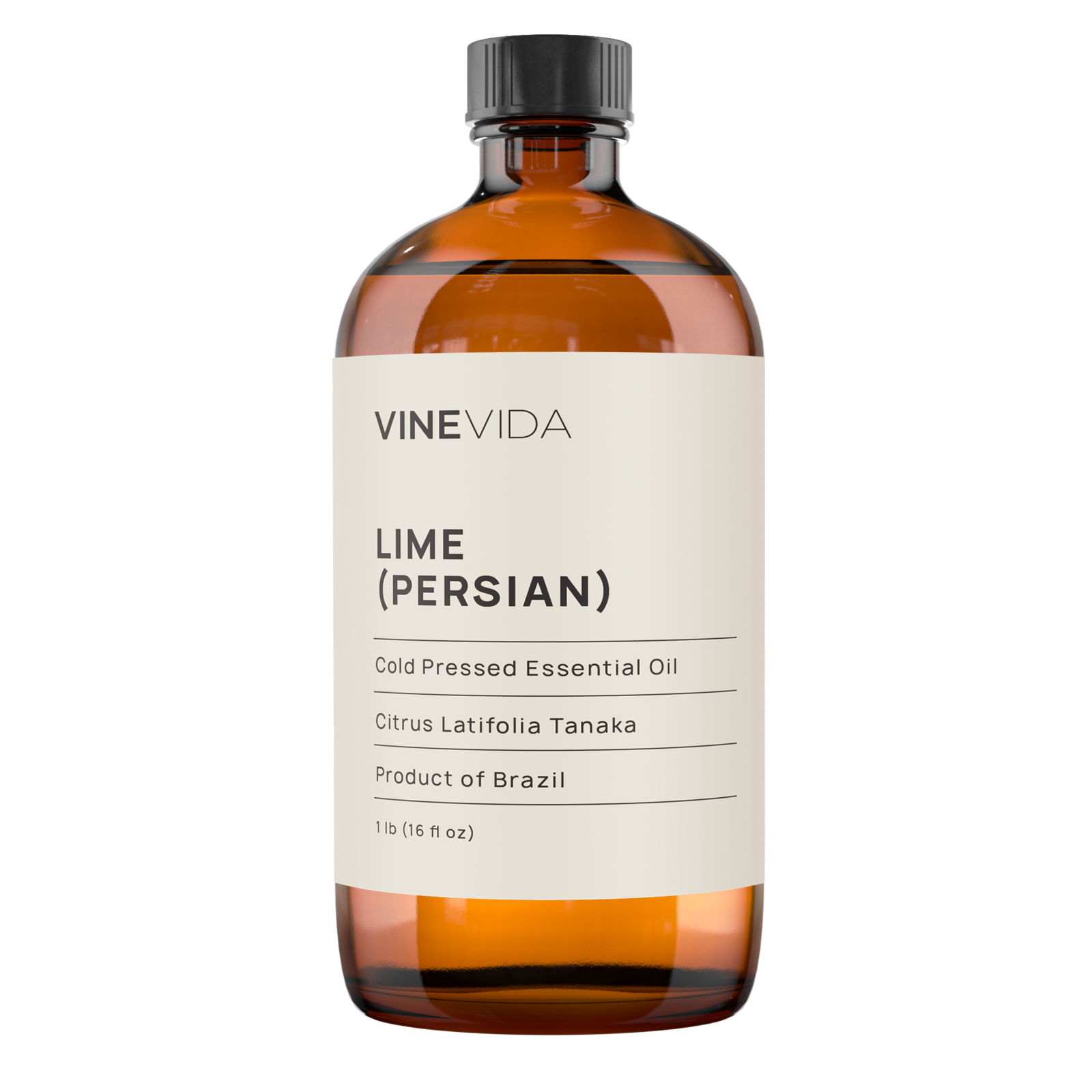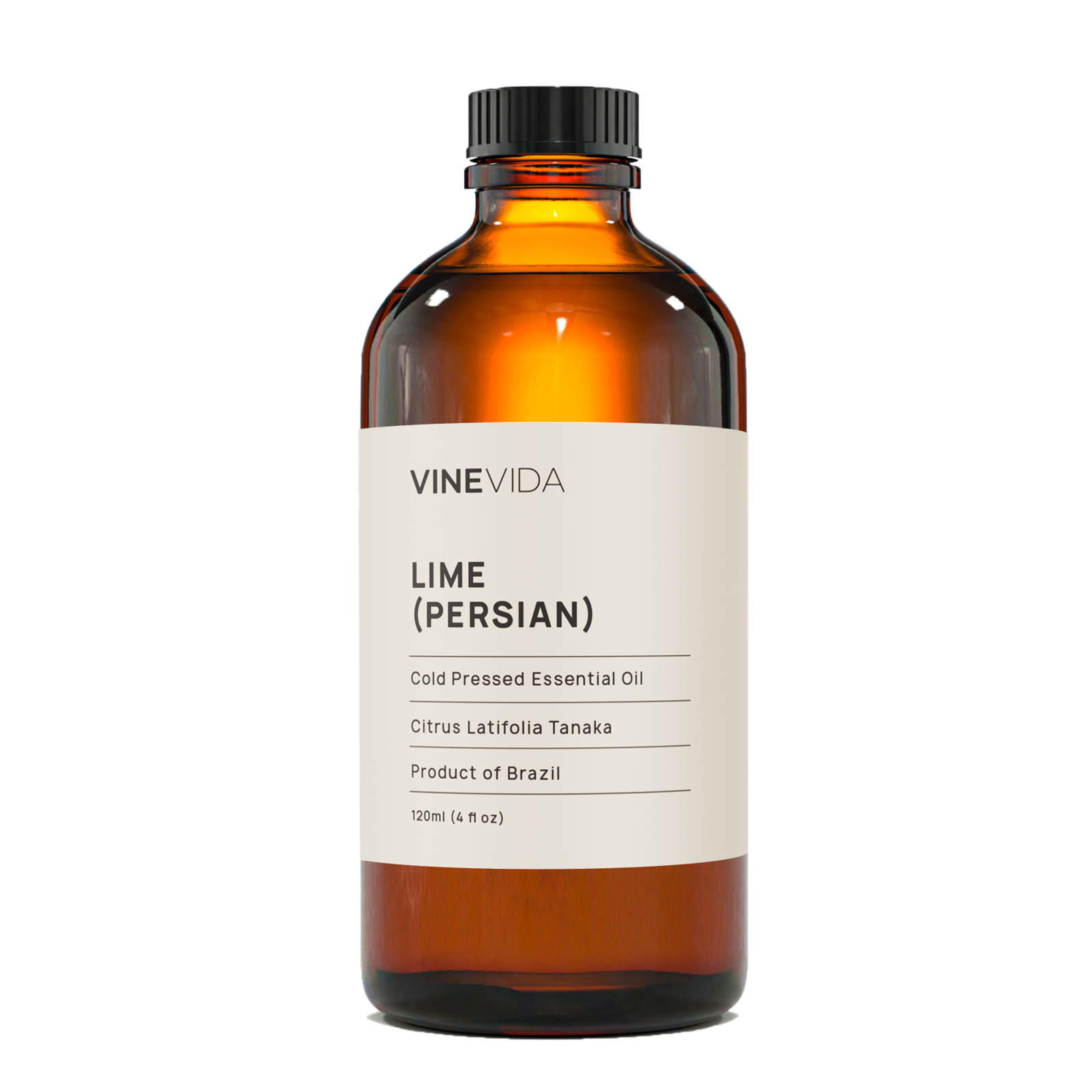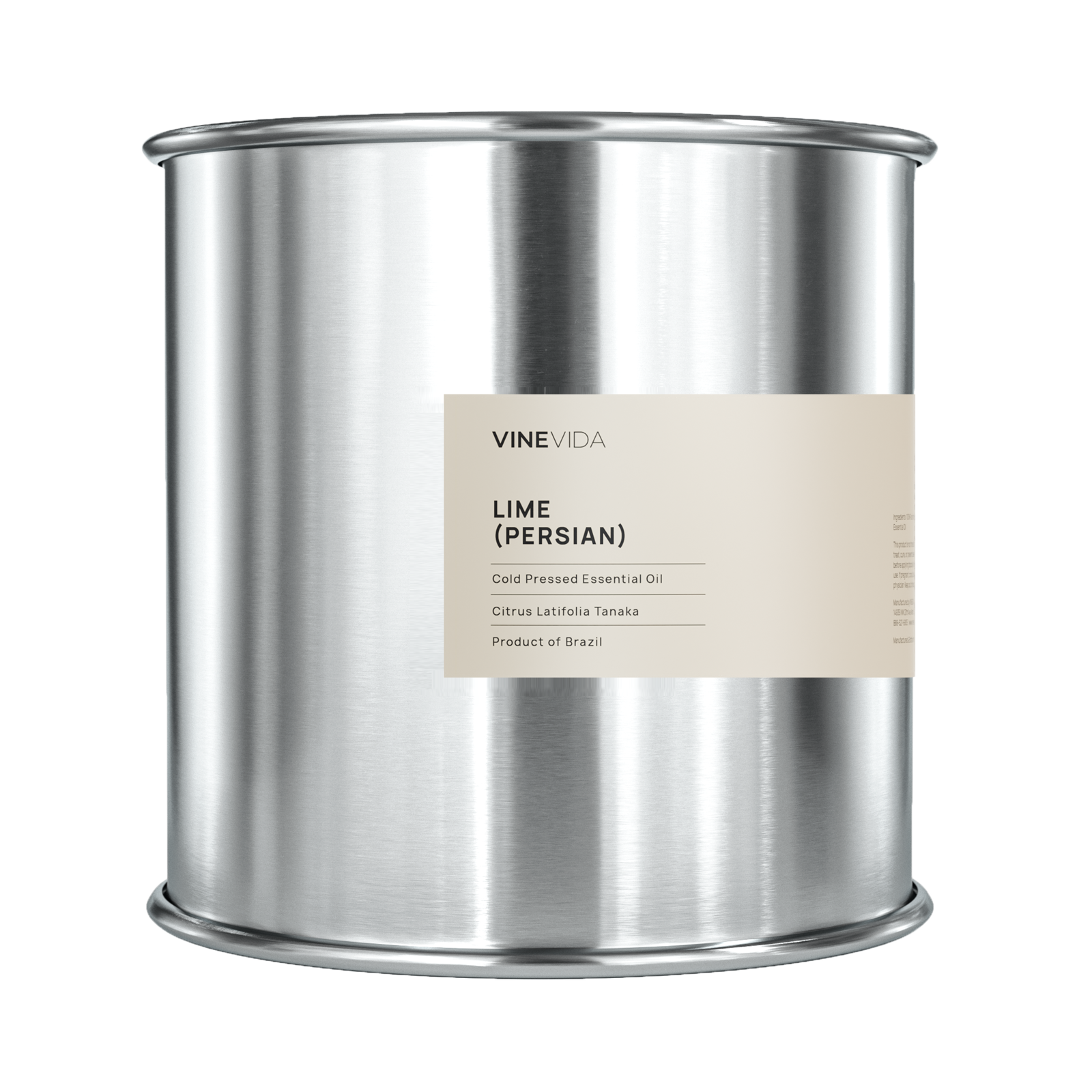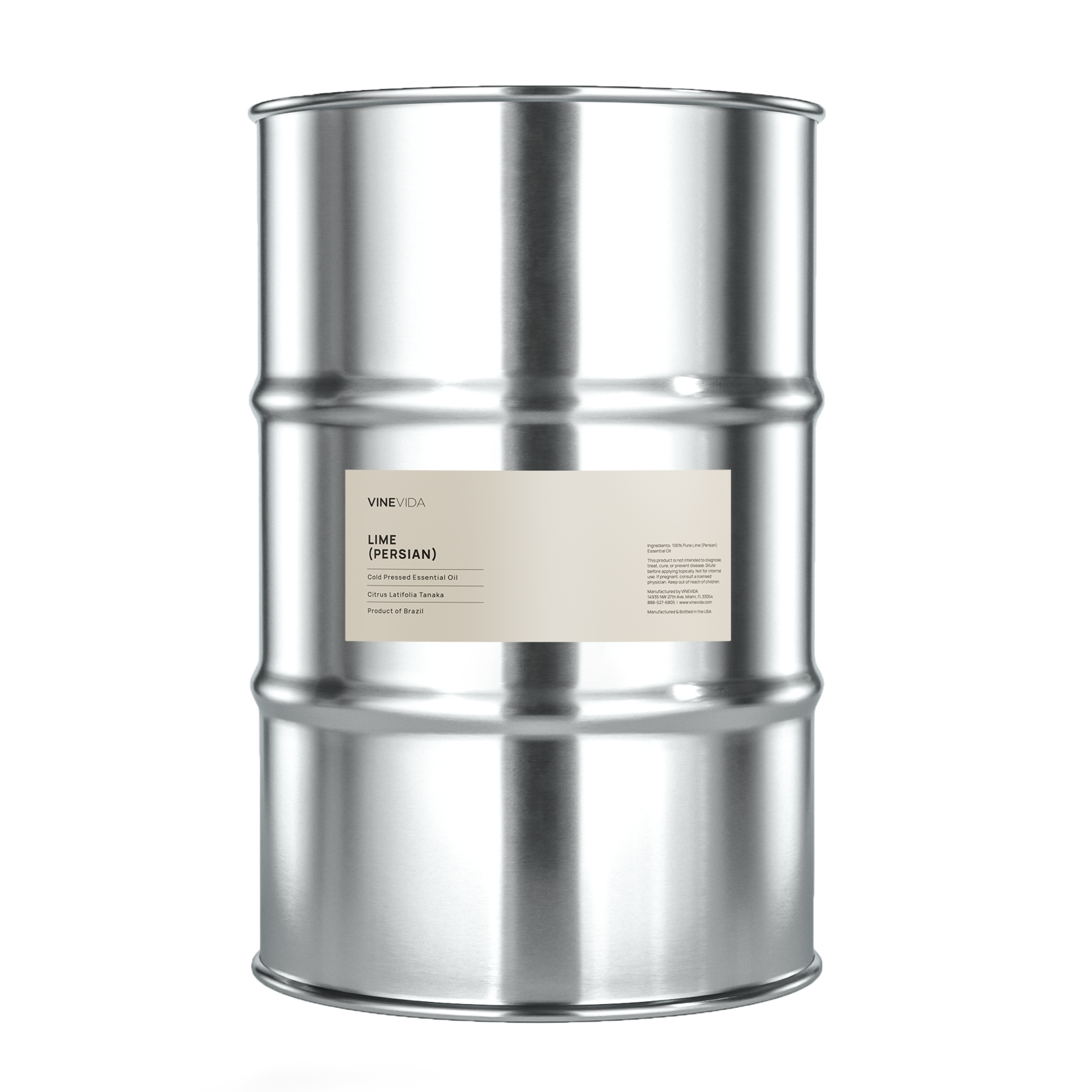Scientific Name: Citrus Latifolia
Origin: Mexico
Plant Part: Peel
Scent: Tart, Fresh, and Fruity
Color: Clear, Yellowish Green to Greenish-Brown liquid
Consistency: Thin
Perfumery Note: Top
Initial Aroma Strength: Medium
Extraction Method: Cold Pressed
Lime Essential Oil: Benefits, Uses & Blends
With its fresh and zesty aroma, lime essential oil ranks high on our list of favorites in terms of scent. Thankfully, its citrusy fragrance isn’t the only thing this oil has going for it. Lime oil’s astringent properties make it a great addition to skincare products, and it is a common ingredient in many perfumes, natural cleaning products, and soaps.
The Persian lime VINEVIDA uses for our lime essential oil is one of the most commonly cultivated limes in the world. As the name indicates, this citrus is native to Persia, though Brazil now dominates in terms of export and trade. The Persian lime is yellow when ripe, but is traditionally sold while still green. It is a hybrid fruit, which means it only grows through cultivation. It is a cross between a key lime (which is also a hybrid) and a lemon.
Interesting fact: British sailors earned the nickname “limey” because of the limes included in their rations. A British doctor found that if the sailors included lime in their diet it would prevent scurvy, enabling them to stay at sea for longer durations of time.
Lime Essential Oil: Modern Uses
Today the Persian lime is very versatile. Limes are common ingredients in food and beverages, valued for their acidity and aroma. Lime essential oil, on the other hand, is a common ingredient in many fragrances, cosmetics, cleaning products, and soaps. It is also common in aromatherapy, due to its fresh, uplifting scent.
Lime Essential Oil Benefits: Component Breakdown
- Limonene: Limonene is known to have antioxidant and anti-inflammatory properties. It is a key ingredient in cleaning products, insect repellents, food and beverages, and even cosmetics. It is most commonly found in the rind of citrus fruits, though you will find it in other essential oils as well.
- y-Terpinene: y-Terpinene is a component also found in Orange Oil, Tea Tree Oil, and Pine Oil. It is a common additive in foods and cosmetics. It makes sure of many lime essential oil benefits.
- Esters: Esters are derived from acids and are often found in essential oils. Their fruity aroma helps to enhance flavor, but they are also great emulsifiers. This means esters benefit the skin, helping to keep it smooth and soft.
- Monoterpene aldehydes: Citral is common to the rind of citrus fruits, and is known as a monoterpene aldehyde. Citral’s fragrant aroma means it is a common additive to cosmetics and perfumes, but studies also indicate it has an antioxidant effect.
- b-Pinene + sabinene: b-Pinene shows indications of being a powerful antimicrobial and antibacterial agent. One study in particular found it to be particularly effective against Candida albicans. It is often an additive in dairy products, as well as in some of the items common to bakeries.
- Sesquiterpenes: Sesquiterpenes are natural components which are found in plants. Their main aim is to offer plant protection, which happens in a variety of different ways. In addition, studies done on sesquiterpenes show indications these compounds may be effective anti-inflammatory agents
- Aliphatic aldehydes: Aliphatic aldehydes are building blocks for more complex compounds.
Lime Essential Oil Uses: For Wholesale Purposes
Demand for essential oils is steadily rising as companies and consumers move towards more natural products. Known primarily for its zesty aroma, lime essential oil uses are beginning to expand as consumers realize this citrus fruit’s versatility. In this section, we will cover the varied uses of lime oil in more detail.
Fragrance
Lime essential oil benefits those who are in the cosmetic and fragrance industry. The term “fragrance” is considered a trade secret. When you see this word on an ingredient list, it is likely hiding potentially harmful toxins and irritants. This is because companies have no requirement to disclose the ingredients that make up the fragrance in their product, due to this industry loophole. As more consumers begin to demand transparency in their products, businesses are making the move towards safer, more natural options. Lime oil has a strong, fruity scent which makes it perfect for perfumes and cosmetics. In fragrance terms this oil is a top note, meaning it’s one of the first scents you will detect.
Cosmetics
The lime essential oil uses include cosmetics as well. Similar to fragrances, many cosmetics, and toiletries contain lime essential oil for its tart, sweet scent. However, the presence of citral also makes lime oil an astringent. This means it can be very effective in facial cleansing products and toners, particularly those that target acne.
Soap Making

Soapmaking is another one from the lime essential oil uses list. Common soaps often contain many chemicals and toxins. As more and more people begin to gravitate towards organic, natural products, the essential oil soap market is picking up. Forecasts estimate that the global value for essential oil soaps will be around US $458.6 million by 2026; this is almost double what the value was in 2016. Lime essential oil blends of soap offer astringent properties, as well as acting as emulsifiers on the skin. Add in lime oil’s fresh, citrusy scent, and you have the perfect essential oil for soap making!
Candles
Similar to soap, many candles found in stores can expose purchasers to harmful chemicals. Paraffin—one of the most common waxes on the market—gives off benzene when burning. Benzene is a known carcinogen, yet paraffin candles are still sold almost everywhere with no warning. Safer options include beeswax and soy wax, but many of these candles also include the dreaded “fragrance” on their ingredient list.
However, as consumers become more conscious of these things, the demand for essential oil candles is rising. Statistics show one of the most important factors when purchasing candles is scent. The potency of essential oils means only a few drops will offer a strong fragrance that lasts. Lime essential oil is a great option for citrusy, summer-scented candles, perfect for the patio season or for adding a bit of cheer to dreary winter days.
Aromatherapy
Scientific evidence indicates essential oils can affect both brain waves and behavior. Many medical professionals are beginning to suggest the use of aromatherapy as an adjunct to conventional medicine, particularly with patients suffering from stress and anxiety. Lime essential oil aromatherapy is becoming popular due to its mood-lifting fragrance and the potential health benefits it offers. This oil is good for use in any of the three categories of aromatherapy: cosmetic, massage, and olfactory.
Lime Essential Oil: Popular Blends
As stated earlier, lime essential oil is a top note. When blending top notes it's essential to keep in mind they are highly volatile, meaning they will dissipate quickly.
Members of the mint family—such as Spearmint and Peppermint—blend particularly well with citrus oils. The addition of a base note oil will help ground the blend, helping to sustain the citrus scent longer. Some examples of base notes that pair well with lime essential oil are Jasmine, Ylang-Ylang, and Balsam Fir.
Lime Essential Oil: DIY Around the House
As essential oils become more popular, so does using them in DIY projects around the house. Try using lime essential oil in this multi-purpose scrub to help get sinks, bathtubs, and showers sparkling:
- Mix ¼ c of natural liquid dish soap with 1 cup of baking soda.
- Add in 10 drops each of Lime Essential Oil, Lemon Essential Oil, and Grapefruit Essential Oil.
This will form a paste. Use as necessary and rinse off.
Is Lime Essential Oil Safe for Pets?
No. Lime essential oil contains limonene, which can cause severe damage to the livers of cats or dogs with weaker immune systems. Both animals tend to lick their fur and paws when grooming, so it's easy for them to inadvertently come in contact with oils that are being diffused into the air. You should never let your pet ingest, or come in direct contact with any essential oils. Make sure to keep lime essential oil well out of reach to prevent any accidents from occurring.
Precautions
It isn’t uncommon to see or hear suggestions relating to the ingestion of lime essential oil. However, here at VINEVIDA we strongly discourage this practice. You have likely heard the saying oil and water don’t mix, and it’s true. Oils will separate from water, and due to the potency of essential oils, this means it is difficult for cells and organs to digest. It can cause irritation, ulcerations, and other potentially dangerous reactions. For more information on ingesting essential oils, and the safe way to do so, check out this article.
Why Choose VINEVIDA?
Here at VINEVIDA, we believe in educating our customers on how to use essential oils sustainably and responsibly. We want them to enjoy the full benefit of what essential oils have to offer, which is why we only sell premium products. All of our oils are pure, and we provide the testing data to prove it. Furthermore, VINEVIDA offers competitive wholesale pricing to support like-minded businesses who believe in safe, clean, products.
Flash Point
55° C
Lime Essential Oil: Conclusion
Lime essential oil benefits are plentiful, as are the range of uses available. While many companies out there hide behind the label of “fragrance”, at VINEVIDA we pride ourselves in offering consumers an alternative option. Lime essential oil’s fresh, cheerful scent is a natural solution that many products can benefit from.

- Reviews
- Questions



You may also like
Recently viewed














 Safety Data Sheet
Safety Data Sheet


















